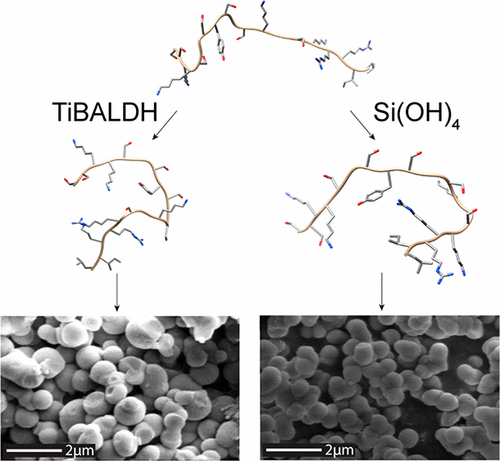Our official English website, www.x-mol.net, welcomes your
feedback! (Note: you will need to create a separate account there.)
Comparative Study of Secondary Structure and Interactions of the R5 Peptide in Silicon Oxide and Titanium Oxide Coprecipitates Using Solid-State NMR Spectroscopy
Langmuir ( IF 3.7 ) Pub Date : 2017-09-25 00:00:00 , DOI: 10.1021/acs.langmuir.7b01048 Erika L. Buckle 1 , Adrienne Roehrich 1 , Branden Vandermoon 1 , Gary P. Drobny 1
Langmuir ( IF 3.7 ) Pub Date : 2017-09-25 00:00:00 , DOI: 10.1021/acs.langmuir.7b01048 Erika L. Buckle 1 , Adrienne Roehrich 1 , Branden Vandermoon 1 , Gary P. Drobny 1
Affiliation

|
A biomimetic, peptide-mediated approach to inorganic nanostructure formation is of great interest as an alternative to industrial production methods. To investigate the role of peptide structure on silica (SiO2) and titania (TiO2) morphologies, we use the R5 peptide domain derived from the silaffin protein to produce uniform SiO2 and TiO2 nanostructures from the precursor silicic acid and titanium bis(ammonium lactato)dihydroxide, respectively. The resulting biosilica and biotitania nanostructures are characterized using scanning electron microscopy. To investigate the process of R5-mediated SiO2 and TiO2 formation, we carry out 1D and 2D solid-state NMR (ssNMR) studies on R5 samples with uniformly 13C- and 15N-labeled residues to determine the backbone and side-chain chemical shifts. 13C chemical shift data are in turn used to determine peptide backbone torsion angles and secondary structure for the R5 peptide neat, in silica, and in titania. We are thus able to assess the impact of the different mineral environments on peptide structure, and we can further elucidate from 13C chemical shifts change the degree to which various side chains are in close proximity to the mineral phases. These comparisons add to the understanding of the role of R5 and its structure in both SiO2 and TiO2 formation.
中文翻译:

使用固态NMR光谱比较氧化硅和氧化钛共沉淀物中R5肽的二级结构和相互作用的比较
作为工业生产方法的替代方法,仿生,肽介导的无机纳米结构形成方法引起了极大的兴趣。为了研究肽结构的在二氧化硅(二氧化硅的作用2)和二氧化钛(二氧化钛2)的形态中,我们使用从silaffin蛋白质衍生以产生均匀的SiO的R5肽结构域2和TiO 2层的纳米结构从所述前体硅酸和钛双(乳酸铵)使用扫描电子显微镜表征所得的生物二氧化硅和生物二氧化钛纳米结构。研究R5介导的SiO 2和TiO 2的过程形成后,我们对具有均匀13 C和15 N标记残基的R5样品进行1D和2D固态NMR(ssNMR)研究,以确定主链和侧链化学位移。13 C化学位移数据又用于确定纯硅胶,氧化钛和二氧化钛中R5肽的肽骨架扭转角和二级结构。因此,我们能够评估不同矿物质环境对肽结构的影响,并且我们可以从13 C化学位移进一步阐明改变各种侧链与矿物质相非常接近的程度。这些比较增加了对R5的作用及其在SiO 2和TiO 2中的结构的理解。 编队。
更新日期:2017-09-25
中文翻译:

使用固态NMR光谱比较氧化硅和氧化钛共沉淀物中R5肽的二级结构和相互作用的比较
作为工业生产方法的替代方法,仿生,肽介导的无机纳米结构形成方法引起了极大的兴趣。为了研究肽结构的在二氧化硅(二氧化硅的作用2)和二氧化钛(二氧化钛2)的形态中,我们使用从silaffin蛋白质衍生以产生均匀的SiO的R5肽结构域2和TiO 2层的纳米结构从所述前体硅酸和钛双(乳酸铵)使用扫描电子显微镜表征所得的生物二氧化硅和生物二氧化钛纳米结构。研究R5介导的SiO 2和TiO 2的过程形成后,我们对具有均匀13 C和15 N标记残基的R5样品进行1D和2D固态NMR(ssNMR)研究,以确定主链和侧链化学位移。13 C化学位移数据又用于确定纯硅胶,氧化钛和二氧化钛中R5肽的肽骨架扭转角和二级结构。因此,我们能够评估不同矿物质环境对肽结构的影响,并且我们可以从13 C化学位移进一步阐明改变各种侧链与矿物质相非常接近的程度。这些比较增加了对R5的作用及其在SiO 2和TiO 2中的结构的理解。 编队。









































 京公网安备 11010802027423号
京公网安备 11010802027423号